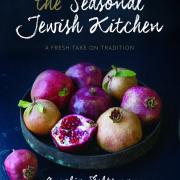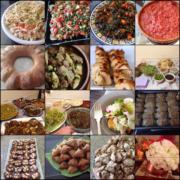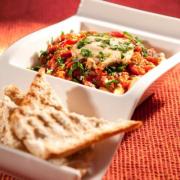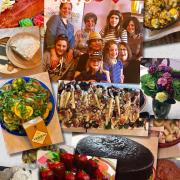The Seasonal Jewish Kitchen Cookbook. Amelia Saltsman. My Review
Amelia Saltsman’s the Seasonal Jewish Kitchen, is nothing short of magnificent.
Order Your Copy on Amazon Today! Well priced too!
Heaven Help me I just fell in love with it! If there were (of course there were, often for good reason!) any lingering biases about Jewish Food being stodgy, sappy or heavy-handed, they were just swept away by Amelia’s Book and by the great Deborah Madison‘s glowing foreword of it. As the book’s subtitle aptly states, The Seasonal Jewish Kitchen Cookbook is a fresh take on tradition.
No stripe of the Jewish Culinary Diaspora has been overlooked in the Seasonal Jewish Kitchen.
We are all there, prominently displayed on the pages, one big happy, sensuous and hungry family, cooking all over the world with the most luscious sizzling farm-fresh ingredients: From Eastern Europe to Israel to Yemen, and everywhere in between. Abundant, generous and incredibly beautiful photographs by Stacy Valentine make the pages fairly come to life and push you into the kitchen, leaving you practically no choice but to roll up your sleeves, tie your apron strings and make one of the dishes in the Seasonal Jewish Kitchen. Now.
You will love Amelia’s description of how the Seasonal Jewish Kitchen was conceived:
Her tsimmis recipe, which aired on radio and television, garnered thousands of viewers and listeners and well viral on social media. Since I couldn’t possibly express it more eloquently, and since in my view it captures the whole essence of the book, I am leaving Amelia’s own words and voice intact: “In the instant that tradition and technology collided, it dawned on me that many cooks are seeking the kind of Jewish cooking I do: modern, seasonal, ingredient-driven, lighter and brighter… and reflective of the many flavors of the Jewish Diaspora”. And sure enough, The Seasonal Jewish Kitchen accomplishes that and much more.
In the Seasonal Jewish Kitchen, in keeping with Amelia’s desire for seasonal cooking, the recipes are organized according to the times of year. Just like the pictures that accompany them, the recipes are vibrant, concise and clear. Short and sweet and dazzling ingredient list across the board. Just naming the recipes will make your tongue smile: Listen to this: Apple, fennel and watermelon radish salad; blistered chicories with tuna and salsa verde; silan and tahini ice cream sundaes; European plum meringue torte; roasted Romanian ratatouille; pure and simple brisket; grilled corn with zaatar; simple farro soup with chickpeas and escarole; whole fish with preserved lemon and herbs; one-pan striped bass with fennel, potatoes and cream; my (Just to be clear: Amelia’s) grandmother Rachel’s apricot preserves. And on and on, one dish more enticing and more beautiful than the next.
Lots of success to Amelia and the beautiful Seasonal Jewish Kitchen!
I couldn’t resist including the following dish as a parting gift, which looks and sounds drop dead delicious:
Braised Lamb Shanks with Crisped Artichokes and Gremolata.
- When the Israelites were about to make their escape from Egypt, they were commanded to eat a last meal, standing, dressed, and ready to run. The shank bone on the Seder plate is a vestige of that meal of fire-roasted lamb, unleavened bread, and bitter herb. The commemorative Passover meal, as set forth in the Bible, on the other hand, is to be the exact opposite, leisurely with plenty of time for storytelling. A main course of slow-braised (do-ahead) lamb shanks reinforces the difference between this and all other nights. Lamb and artichokes are a natural pairing throughout the spring season. Serve with Basic White Rice (page 21) or Sarah’s Steamed Potatoes (page 221).
- 3 tablespoons olive oil
- 6 meaty lamb shanks, about 1¼ pounds (570 g) each
- Kosher or sea salt and freshly ground black pepper
- 1 onion, finely chopped
- 1 carrot, peeled and finely chopped
- 2 ribs celery, finely chopped
- ¼ cup (15 g) chopped fresh Italian parsley
- Several thyme sprigs
- 2 bay leaves, preferably fresh
- 2 large cloves garlic, minced
- 1 cup (240 ml) dry white wine
- Grated zest and juice of 1 lemon
- 2 cups (480 ml) beef stock (page 66), or 1 cup (240 ml) canned beef broth diluted with 1 cup (240 ml) water
- Crisped Artichokes with Gremolata (page 184)
Heat a large, wide pot over medium-high heat and add 1 tablespoon of the oil. Season the lamb shanks with salt and add them to the pot, working in batches to avoid crowding. Brown well on all sides, 10 to 12 minutes. Transfer the shanks to a plate and drain the fat from the pan.
Reduce heat to medium-low and add the remaining 2 tablespoons oil along with the onion, carrot, celery, parsley, thyme, and bay leaves. Season vegetables with salt and pepper, stir to scrape up any brown bits, and cook, stirring occasionally, until the vegetables are tender, about 10 minutes. Add garlic and cook for 1 minute more. Pour in the wine, raise the heat to high, and bring to a boil. Cook until the wine has reduced by half, about 5 minutes. Stir in the lemon zest and juice.
Return the lamb to the pot, nestling the shanks together to fit; overlap the bony ends if necessary. At this point, the liquid in the pan should reach no more than halfway up the sides of the shanks. Add a little of the stock if needed. Cover and braise the meat, turning the shanks once after the first hour, until very tender, about 1½ hours. Check the meat every 30 minutes during cooking to be sure there is sufficient liquid, adding stock as necessary to keep the shanks covered about halfway, and that the liquid is simmering rather than boiling vigorously.
Transfer the shanks to a plate. Remove and discard bay leaves and thyme sprigs and pour the sauce and vegetables into a liquid measure or a bowl. You should have about 2 cups (480 ml). Using a large spoon, skim off the fat from the surface of the sauce. Return the meat and sauce to the pot and heat, adding a little stock or water if you feel there isn’t enough sauce, and reheat to serving temperature. Or, refrigerate the sauce and shanks until closer to serving time; the fat will harden and be easy to lift off. Reheat on the stove or in a 350°F (180°C) oven.
Serve the lamb shanks family style or plated, topped with the artichokes and gremolata.












You’ve used many delicious words in your blog about my new book, but this thought may be my favorite: “No stripe of the Jewish Culinary Diaspora has been overlooked in the Seasonal Jewish Kitchen. We are all there, prominently displayed on the pages –”
Thank you Levana, for this glowing review!
Dear Amelia you are most welcome. Well deserved too!